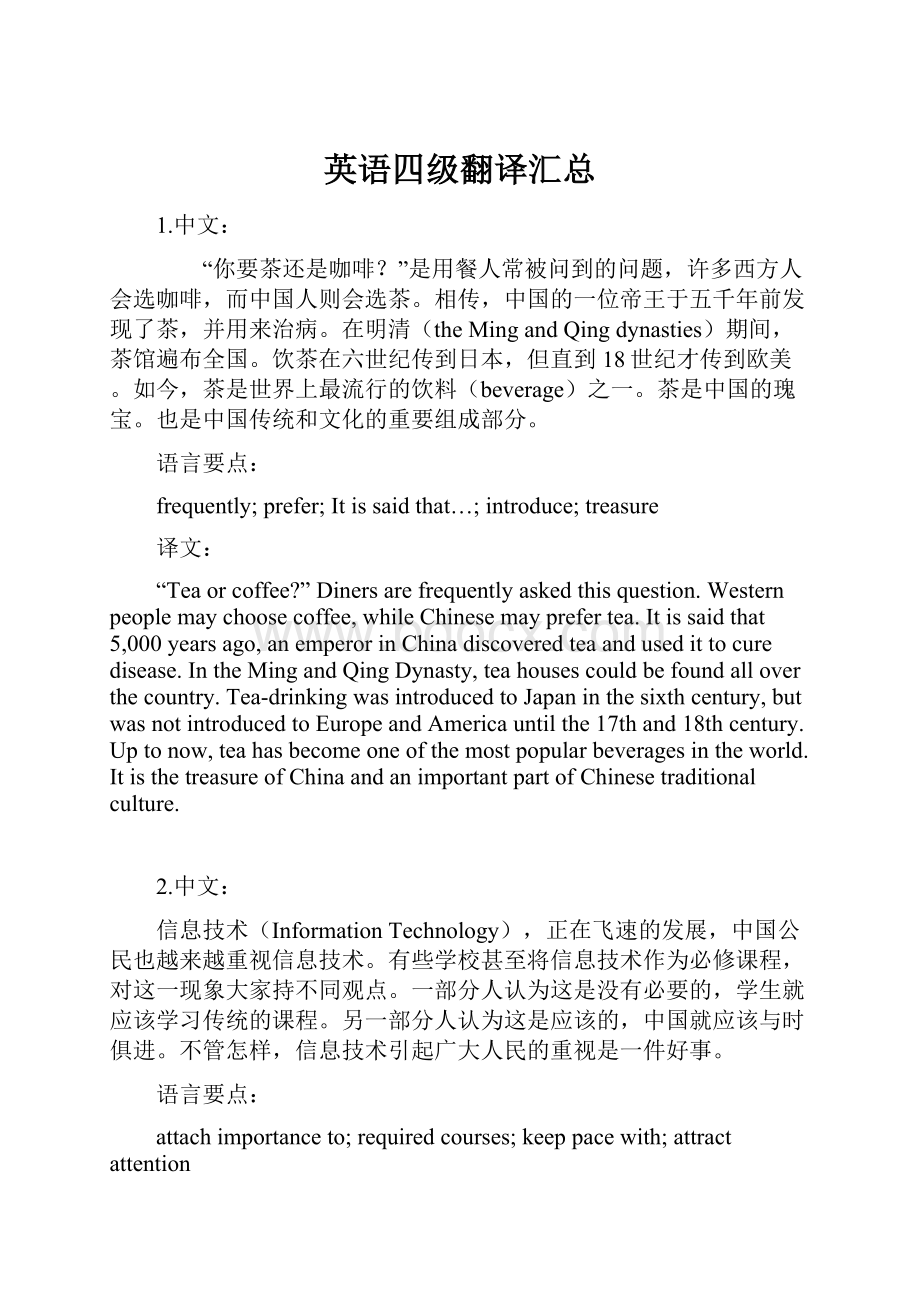英语四级翻译汇总.docx
《英语四级翻译汇总.docx》由会员分享,可在线阅读,更多相关《英语四级翻译汇总.docx(19页珍藏版)》请在冰豆网上搜索。

英语四级翻译汇总
1.中文:
“你要茶还是咖啡?
”是用餐人常被问到的问题,许多西方人会选咖啡,而中国人则会选茶。
相传,中国的一位帝王于五千年前发现了茶,并用来治病。
在明清(theMingandQingdynasties)期间,茶馆遍布全国。
饮茶在六世纪传到日本,但直到18世纪才传到欧美。
如今,茶是世界上最流行的饮料(beverage)之一。
茶是中国的瑰宝。
也是中国传统和文化的重要组成部分。
语言要点:
frequently;prefer;Itissaidthat…;introduce;treasure
译文:
“Teaorcoffee?
”Dinersarefrequentlyaskedthisquestion.Westernpeoplemaychoosecoffee,whileChinesemayprefertea.Itissaidthat5,000yearsago,anemperorinChinadiscoveredteaandusedittocuredisease.IntheMingandQingDynasty,teahousescouldbefoundalloverthecountry.Tea-drinkingwasintroducedtoJapaninthesixthcentury,butwasnotintroducedtoEuropeandAmericauntilthe17thand18thcentury.Uptonow,teahasbecomeoneofthemostpopularbeveragesintheworld.ItisthetreasureofChinaandanimportantpartofChinesetraditionalculture.
2.中文:
信息技术(Information Technology),正在飞速的发展,中国公民也越来越重视信息技术。
有些学校甚至将信息技术作为必修课程,对这一现象大家持不同观点。
一部分人认为这是没有必要的,学生就应该学习传统的课程。
另一部分人认为这是应该的,中国就应该与时俱进。
不管怎样,信息技术引起广大人民的重视是一件好事。
语言要点:
attachimportanceto;requiredcourses;keeppacewith;attractattention
译文:
Nowadays,withthefastdevelopmentofInformationTechnology,Chinesecitizensareattachingmoreandmoreimportancetoit.SomeschoolsanduniversitieshaveevenincludedInformationTechnologyintheirrequiredcourses,whichhasledtodifferentopinions.SomepeoplethinkitisunnecessarytomakeITcoursesrequired,andstudentsaresupposedtotaketraditionalcourses.However,otherpeoplethinkitisnecessarytodoso,forChinaanditspeopleshouldkeeppacewiththetimes.Eitherway,itisagoodthingthatInformationTechnologyhasattractedpeople'sattention.
3.中文:
许多人喜欢中餐。
在中国,烹饪不仅被视为一种技能,而且也被视为一种艺术。
精心准备的中餐既可口又好看。
烹饪技艺和配料在中国各地差别很大。
但好的烹饪都有一个共同点,总是要考虑到颜色、味道、口感和营养(nutrition)。
由于食物对健康至关重要,好的厨师总是努力在谷物、肉类和蔬菜之间取得平衡,所以中餐既味美又健康。
语言要点:
bekeenon;beregardedas;elaborately;vary;have…incommon;strikethebalancebetween…and…
译文:
ManypeoplearekeenonChinesecuisine.InChina,cuisineisnotonlyregardedasatechnique,butalsoasakindofart.Theelaboratelypreparedfoodisbothdeliciousandgood-looking.ThewayofcookingandselectionofingredientsvarygreatlyacrossChina.However,goodcuisinehasonethingincommon,thatis,color,flavor,tasteandnutritionshouldallalwaysbeconsidered.Sincefoodplaysanimportantroleinourhealth,anexpertcookalwaystriestheirbesttostrikethebalancebetweenthegrain,meatandvegetables.Therefore,Chinesecuisineistastyandhealthy.
4.中国传统思想—诚实守信
中文:
中国古代有很多关于诚实守信的古话,比如:
言必行,行必果。
这些流传了千百年的古话,都形象地表达了中华民族诚实守信的品质。
在中国几千年的文明史中,人们不但对诚实守信的美德大加赞赏,而且努力地身体力行。
孔子早在2000多年前就教育他的弟子(disciple),在学习中知道的就说知道,不知道的就说不知道,这不仅是对待学习的正确态度,也是诚实的一种表现。
语言要点:
integrity;credit;depict;diligently;reflection
译文:
ThereweremanyoldsayingsaboutintegrityandcreditinancientChina.Forinstance,“Whatissaidcannotbeunsaid”.Theseoldsayingshavelastedforhundredsandthousandsofyears.TheydepictvividlyChinesenationwiththequalityofbeinghonestandkeepingtheirwords.Forthousandsofyears,thesequalitieshavebeenhonoredandpracticeddiligently.About2000yearsago,Confuciustaughthisdisciplesthatwhenyouknowathing,totellthatyouknowit;andwhenyoudonotknowathing,toadmitthatyoudonotknowit.Thisisnotonlytherightattitudetowardstudybutalsoareflectionofintegrity.
5.中国传统思想-佛学思想-1
中文:
佛教(Buddhism)发源于印度,早在汉代(theHanDynasty)就已经传入中国。
佛教在中国的发展过程中不断中国化,逐渐发展成深刻影响中国人思想和生活习惯的宗教思想体系——佛学思想。
佛教中国化的重要时期是在隋唐时期(theSuiandTangdynasties),在这一时期随着国家的统一、经济的发展和文化交流的日益频繁,佛学获得了空前的繁荣发展。
语言要点:
originate;adapt…into…;localization;unprecedentedly;prosperousdevelopment
译文:
BuddhismoriginatedfromancientIndiaandhadbeenintroducedtoChinaasearlyastheHanDynasty.DuringitsdevelopmentinChina,BuddhismconstantlyadapteditselftothelocalcontextinChinasoastobecomeoneofthemostimportantreligionsinChinaandtodeeplyinfluenceonthoughtsandlivinghabitsofChinese.ThelocalizationofBuddhisminChinawasmostimportantintheSuiandTangdynasties.Duringthisperiod,withtheunityofthecountry,thedevelopmentoftheeconomyandthemoreandmorefrequentculturalexchanges,Buddhismgainedanunprecedentedlyprosperousdevelopment.
6.中国传统思想—孔子
中文:
孔子(Confucius)思想的特征之一就是强调教育和学习。
他蔑视不加思考而凭直觉认知世界的人。
孔子认为对于一门学科唯一真正的了解来源于长期而细心的学习。
在他看来,学习就是找到一位好老师,并模仿他的言行。
一位好老师应该是一位悉知历史的长者,并启发学生使其进行独立思考,在学习书本知识的同时还要有独立的见解。
语言要点:
feature;despise;havefaithin;intuition;wordsanddeeds;enlighten
译文:
AdistinctivefeatureofConfucius’thoughtishisemphasisoneducationandstudy.Hedespisesthosewhohavefaithinnaturalunderstandingorintuition.Confuciusarguedthattheonlyrealunderstandingofasubjectcomesfromlongandcarefulstudy.Forhim,studymeansfindingagoodteacherandimitatinghiswordsanddeeds.Agoodteacherissomeoneolderwhoisfamiliarwiththepasthistory.Healsomaintainedthatagoodteachershouldenlightenstudentstothinkindependently,andthatstudentsshouldformtheirownideaswhenacquiringknowledgefromtextbooks.
7.中国传统思想—尊老爱幼—2
中文:
尊敬老人、爱护儿童是中华民族的传统美德。
早在汉朝(theHanDynasty)时,政府就曾多次发布命令,提倡、鼓励、奖赏孝敬老人的行为。
中国人对后代的关爱是爱中有教、慈中有严,包含着强烈的道德责任感,爱幼包括抚养后代、正确地养育、为后代提供成功的机会并教育他们如何成为善良的人。
语言要点:
traditionalvirtue;issue;filialrespect;offspring;embody;moralresponsibility
译文:
TorespecttheagedandlovetheyoungisoneofthetraditionalvirtuesofChinesenation.InasearlyastheHanDynasty,thegovernmentissuedfrequentlyordersadvocating,encouragingandrewardingbehaviorsrelatedtotreatingtheseniorwithfilialrespect.Chinesepeopletreattheiroffspringwithloveandeducation,withkindnessandstrictness,embodyingastrongsenseofmoralresponsibility.Lovingtheyoungincludesprovidingfortheyoungerones,raisingthemcorrectly,givingthemtheopportunitiestheyneedtosucceed,andteachingthemhowtobeagoodperson.
8.中国工艺美术-瓷器-1
中文:
英语中的“china”一词有两个意义,一个是中国,一个是瓷器(porcelain)。
西方人很早就把中国与瓷器联系在一起,这是因为制瓷技术是中国人发明的。
瓷器是从陶器(pottery)发展来的,如果从生产原始瓷器的商代(theShangDynasty)算起,中国的瓷器大约有3000多年的历史了。
中国的制瓷技术从东汉(theEasternHanDynasty)以后发展很快,各个历史时期都出现了别具特色的制作瓷器的名窑(kilns)和陶瓷新品种。
语言要点:
originally;onthebasisof;primitive;uniquefeatures;comeforth
译文:
“China”inEnglishhastwomeanings,Chinaasacountryandchinaasporcelain.WesternershavelinkedthecountryofChinawithporcelainsincealongtimeago,becausethetechniqueofmanufacturingporcelainwasoriginallyinventedinChina.Porcelainwasdevelopedonthebasisofpottery.IfcalculatedfromtheappearanceoftheprimitiveporcelainintheShangDynasty,ithasahistoryofabout3000years.ThetechniquesofmanufacturingporcelainhavedevelopedrapidlysincetheEasternHanDynasty.Famouskilnsproducingporcelainproductswithuniquefeaturesandnewpotteryandporcelainvarietiesconstantlycameforthinthefollowingdynasties.
9.中国工艺美术-刺绣-1
中文:
中国是丝绸的故乡,产生了很多与丝绸相关的艺术,刺绣(embroidery)就是其中的一种。
刺绣在中国有数千年的历史,受到人们的广泛喜爱。
刺绣可用来装饰衣服、被子、枕头等,刺绣本身也可制作成饰品(ornament)。
中国有“四大名绣”,即苏州的苏绣、广东的粤绣、湖南的湘绣以及四川的蜀绣,各种绣法不仅风格有差异,所选择的主题也有所不同。
历史上有“苏绣猫,湘绣虎”的说法。
粤绣擅长绣鸟类,而蜀绣则擅长绣山水人物。
语言要点:
behometo;applyto;respectively
译文:
Chinaishometosilkandavarietyofartsrelatedtosilk,oneofwhichisembroidery.Withalonghistoryofseveralthousandyears,embroideryhasbeenaloveoftheChinesepeople.Itisappliedtoadornclothes,quiltsandpillowcases,orapieceofembroideryworkcanbeornamentinitself.Chinahasfourfamoustypesofembroidery–respectivelyfromSuzhou,Guangdong,Hunan,andSichuan–eachwithitsownstyleanddifferentthemes.Historically,Suzhouembroiderywasfamousforitscats,Hunanembroideryforitstigers,GuangdongembroideryforitsbirdsandSichuanembroideryforitslandscapesandhumanfigures.
10.中国工艺美术-灯彩-2
中文:
在春节、元宵节等节假日,无论是中国的城市还是乡村,灯彩(fancylantern)都作为装饰被广泛的应用。
现在,每逢节日中国各地仍然举行各种大型的灯会,灯会上除了展览各种传统的灯彩,还展出许多运用现代科学技术制作的彩灯。
此外,在北京和哈尔滨等北方城市,每年冬季还要举行冰灯灯会(lanternfairs)。
用冰块雕刻(carve)成的高大的建筑、可爱的动物和神话传说中的仙女,在灯光的照耀下,仿佛把人们带到了奇妙的世界(wonderland)。
语言要点:
bewidelyused,inruralandurbanareas,apartfrom,inaddition
译文:
FancylanternsarewidelyusedfordecorationsinbothruralandurbanareasinChinaonNewYear’sDay,theLanternFestivalandotherfestivalsandholidays.LargelanternfairsarestillheldeverywhereinChinaduringfestivals.Apartfromtraditionallanterns,therearemanycolorfullanternsmadewithmoderntechnology.Inaddition,inwinter,citiesinNorthChina,likeBeijingandHarbin,holdIceLanternfestival.Hugesculpturesofbuildingscarvedwithice,cuteanimalsandmythsoffairiesilluminatedbycolorfullightsseemtobringpeopletoamagicalwonderland.
11.中国工艺美术-风筝-1
中文:
风筝,古时候也叫纸鸢(Zhiyuan),是中国人发明的。
相传两千多年前中国著名的工匠鲁班用竹木削制长了会飞的木鹊(bamboomagpie)。
放风筝是一项有益于身体健康的体育活动,所以,世界上许多国家十分流行放风筝。
中国人不仅把放风筝当作有趣的游戏和有益于身体健康的体育活动,也常常把风筝挂在墙壁上作为装饰。
目前,中国的风筝已经远销到日本以及东南亚和欧美的许多国家,受到了世界各国人民的欢迎。
语言要点:
ingeniouscarpenter;flyingkites;bebeneficialto;decoration;gaingreatpopularity
译文:
Kite,alsoknownasZhiyuaninancientChinawasinventedbytheChinesepeople.ItissaidthatLuBan,awell-knowncarpenter,madeabamboomagpiethatcouldfly.Asflyingkitesisbeneficialtoone’shealth,itisgainingpopularityinmanycountries.TheChineseregarditasaninterestinggameaswellasahealthfulsport.Somepeoplehangkitesonthewallfordecoration.ChinesekitesarenowexportedtoJapan,SoutheastAsiaandmanycountriesinEuropeandAmerica.Theygaingreatpopularityamongpeoplearoundtheworld.
12.中国工艺美术-剪纸-2
中文:
中国的剪纸(Chinesepaper-cuts)大多出自农村妇女之手,她们剪刻出的各种花样最贴近农民生活,常常在过年过节时使用。
优雅的(elegant)线条和令人愉悦的形象给中国普通百姓的生活带来了欢乐和喜气(festivity)。
中国剪纸分为两种:
朴素自然的单色剪纸和绚丽(gorgeous)多彩的彩色剪纸。
由于各地人民的生活习惯不同,各地民间剪纸的风格也不同。
内容丰富、花样繁多的民间剪纸,使人们的生活越来越美好。
语言要点:
ruralare